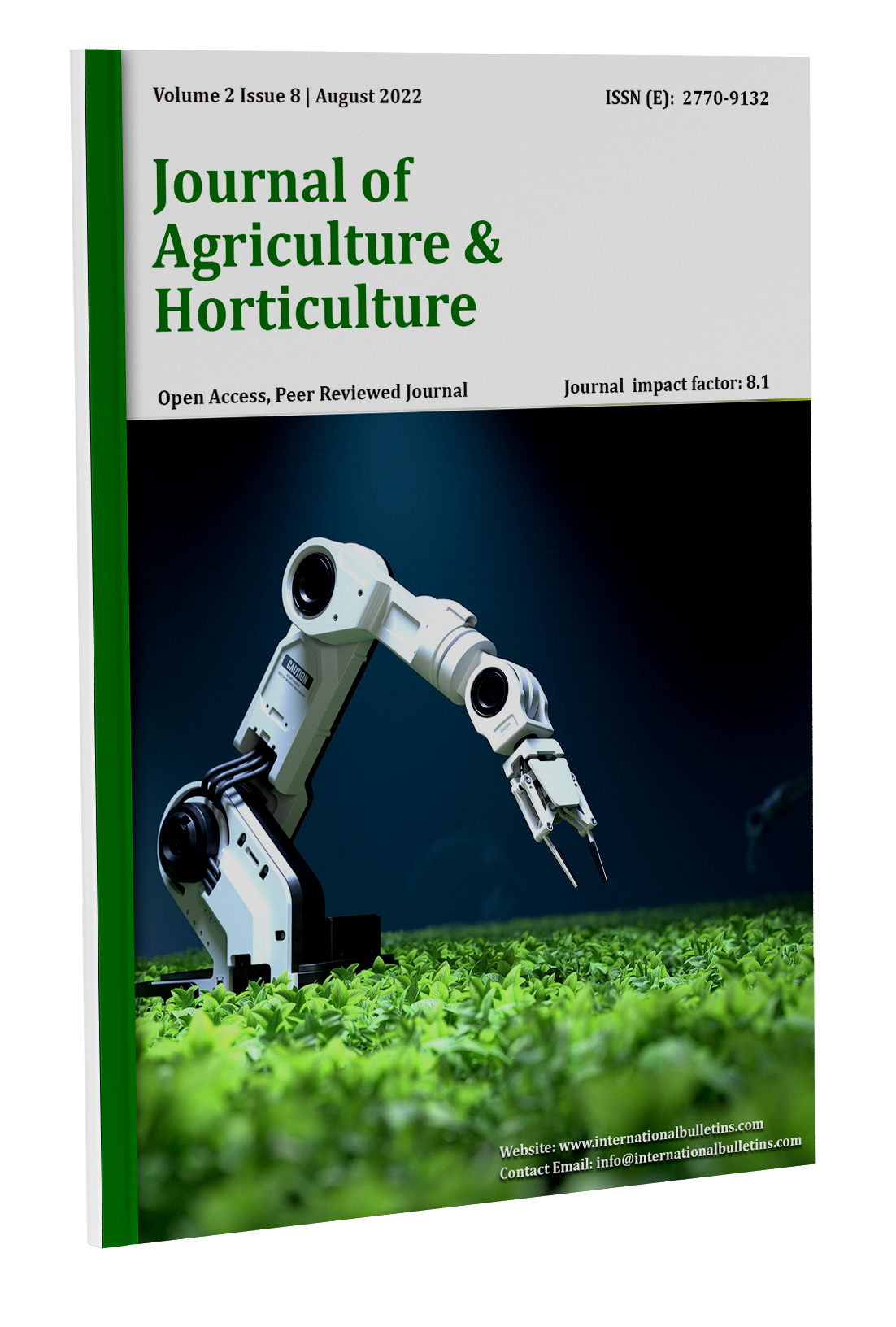STUDYING THE RELATIONSHIP BETWEEN MORPHO-BIOLOGICAL CHARACTERISTICS OF OLIVE PLANTS AND THEIR GROWTH AND DEVELOPMENT IN DRY SUBTROPICAL CLIMATE CONDITIONS
Keywords:
Phenological phase, shoot, flowering, budding, leaf, fruit ripening.Abstract
This article presents data on the study of the relationship between the morphological and biological characteristics of the olive plant and its growth and development in a dry subtropical climate. The results of observations of the phenological phases of the olive tree, including the stages of budding, flowering and fruiting, are presented.
References
Abdullaev V.G. Agroclimatic resources of the Azerbaijan SSR. Abstract of diss for the degree of candidate of geographical sciences. - Baku, 1976, - 22 p.
Alekseev V.P. Olive. Olive tree. Bulletin of the All-Russian Research Institute of Crops, 1954, No. 4. - P. 86-109.
Ali-Zade Mahmud. K. Development of olive culture in Azerbaijan. - Bulletin of the All-Russian Research Institute of Crops, 1954, No. 3. - P. 105-110.
Arendt N.K. On the issues of biology of flowering and fruiting of olive. Tr. GNBS. – Yalta, 1934, v. 14, vyp. 2. – P. 119–185.
Buriev H.Ch., Abdullaev S.B. Development of issues of development biology of olive varieties introduced in Uzbekistan. // International scientific journal “Young scientist” No. 24 (210) / 2018. – P. 109–111.
Gorbey D.E. Olive and its prospects in South-West Turkmenistan. // Soviet subtropics, 1940. No. 5. – 27 p.
Enileev N.Sh., Enileev Sh.N. Use of artificial substrates for growing olive seedlings from green cuttings. // Bulletin of agrarian science of Uzbekistan. Tashkent, 2005. 4(10). – P. 11-12.
Yormatova D.Yo., Khushvaktova H.S., Yuldasheva H.T. The importance of introduction and development of agrotechnology. // Ecology of agricultural production journal. – Tashkent, 2017. – No. 1. – P. 24-25.
Zhigarevich I.A. Agromorphological composition of olive flowers and its influence on yield. – Subtropical crops, 1961, No. 3. – P. 89–99.
Zhigarevich I.A. Agro-rules for olive cultivation. – Baku, 1980. – P. 35-49.
Zhigarevich I.A. On the biology of flowering and ovary shedding in olives.-Proceedings of ANIISiV and subtropical crops, 1962. - P. 3-20.
Kamenkovich S.B. Results of olive variety study in South-West Turkmenistan. - Ashgabat: Bulletin of the Academy of Sciences of the TSSR, series of biological sciences, 1964, No. 5. - P. 75-79.
Karpova G.E. Row spacing system in young olive plantings. In the book: Fruit, vegetable growing and viticulture in Turkmenistan.-Ashgabat, 1975. - P. 65-71.
Kulieva.N.A. Formation of ovule, megasporogenesis and development of female gametophyte of olive in Absheron: Bulletin of the Academy of Sciences of the Azerbaijan SSR, series of biol. sciences, 1969, No. 3, – P. 10–14.
Milanov B.N. Biological and agrotechnical bases of olive culture in the conditions of the Jalalabad Valley of Afghanistan. Abstract of Cand. Sci. (Agricultural Sciences) Diss. – Tashkent, 1977. – P. 12–18.
Milanov B.N. New olive cultivation area. Proceedings of the R.R.Shredr Research Institute of Vegetable Growing and Winemaking. – Tashkent, 1976, v.37. – P. 93–951.
Ramshivili G.G., Barbakadze T.P. Possibilities of development of industrial olive crop in the Georgian SSR. // Subtropical crops, 1976. No. 5-6. – P. 160-163.
Soyunov P. - Biological features of olive growth in the conditions of South-West Turkmenistan. // Young scientist. 2011. No. 7. – P. 148-153.
Sholokhova V.A. Recommendations for laying out industrial olive plantations and caring for them. – Moscow: Kolos, 1984. – P. 29-38.
Sholokhova V.A., Karakhanova S.V. Oil content in fruits of the original parental form and their prospects for hybrids. "New crops in the national economy and medicine" (mat.scient. conf.). – Kyiv, 1976, part 2. – P. 109-117.
Belaj, A., Munoz-Diez, C., Baldoni, L., Satovic, Z., &Barranco, D. (2010). Genetic diversity and relationships of wild and cultivated olives at regionallevel in Spain.ScientiaHorticulturae, 124: P. 323–330.
Belaj, A., Satovic, Z., Rallo, L., & Trujillo, I. (2002). Genetic diversity and relationships in olive (Olea europaea L.) germplasm collections as determined by randomly amplified polymorphic DNA. Theoretical and Applied Genetics, 105(4), P. 638-644.
Charafi, J., El Meziane, A., Moukhli, A., Boulouha, B., El Modafar, C., &Khadari, B. Menara gardens: A Moroccan olive germplasm collectionidentified by a SSR locus-based genetic study. Genet Resour Crop Evol, 2007 – P. 127–136.
Navero, D.B., Cimato, A., Fiorino, P., Romero, L.R., Touzani, A., Castaneda, C., Serafini, F., &Navas, I.T. World catalogue of olive varieties. (1st ed.) .Madrid, Spain: International Olive Oil Council. 2000 – P. 267-279.
Poljuha, D., Sladonja, B., Setic, E., Milotic, A., Bandelj, D., J. Jakse,J.,&Javornik, B.(2008).DNA fingerprinting of olive varieties in Istria (Croatia) by microsatellite markers.ScientiaHorticulturae, 115. – P. 223–230.
Sarri, V., Baldoni, L., Porceddu, A., Cultrera, N.G.M., Contento, A., Frediani, M., Belaj, A., Trujillo, I., &Cionini, P.G. (2006). Microsatellite markers are powerful tools for discriminating among olive cultivars and assigning them to geographically defined populations. Genome, 49. – P. 1606-1615.






